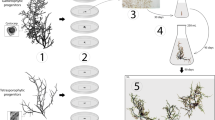Summary
Observations were made of the changes in frequency of two genetically different culture lines ofDaucus carota (designated DBB and DSL) during successive subcultures of mixed cultures. Under conditions of phosphate limited growth, one line (DSL) had a competitive advantage over the other. Under other cultural conditions, this competitive interaction was removed or reversed. Detailed comparisons of the growth patterns and phosphate uptake rates of the two culture lines grown separately allowed prediction of their behaviour in mixed cultures. Deviations of observed from predicted behaviour in mixed cultures demonstrated that the dominant culture line (DSL) could compete more effectively for the available phosphate, thereby modifying the growth of line DBB and causing its elimination from mixed cultures. It is concluded that the phosphate limited medium in which these culture lines were initiated had selected genotypes differing in their efficiencies of phosphate utilisation.
Similar content being viewed by others
References
Bayliss, M. W., 1975 a: The Effects of growthin vitro on the chromosome complement ofDaucus carota L. suspension cultures. Chromosoma51, 401–411.
—, 1975 b: The duration of the cell cycle ofDaucus carota in vivo andin vitro. Exp. Cell Res.92 (1), 31–38.
—, 1977: Factors affecting the frequency of tetraploid cells in a predominantly diploid suspension culture ofDaucus carota. Protoplasma92, 109–115.
—, 1977: The causes of competition between two cell lines ofDaucus carota in mixed culture. Protoplasma92, 117–127.
—, andA. R. Gould, 1974: Studies on the growth in culture of plant cells XVIII. Nuclear cytology ofAcer pseudoplatanus suspension cultures. J. exp. Bot.25, 772–783.
Fawcett, J. K., andJ. E. Scott, 1960: A rapid and precise method for the determination of urea. J. clin. Path.13, 156–159.
Gomori, G., 1942: A modification of the colorimetric phosphorus determination for use with the photoelectric colorimeter. J. Lab. clin. Med.27, 955–960.
Henshaw, G. G., K. K. Jha, A. R. Mehta, D. J. Shakeshaft, andH. E. Street, 1966: Studies on the growth in culture of plant cells. I. Growth patterns in batch propagated suspension cultures. J. exp. Bot.17, 362–377.
Murashige, T., andF. Skoog, 1962: A revised medium for rapid growth and bioassays with tobacco tissue cultures. Physiol. Plant.15, 473–497.
Okamura, S., K. Sueki, andA. Nishi, 1975: Physiological changes of carrot cells in suspension culture during growth and senescence. Physiol. Plant.33, 251–255.
Sacristan, M. D., 1971: Karyotypic changes in callus cultures from haploid and diploid plants ofCrepis capillaris (L.) Wallr. Chromosoma33, 273–283.
Singh, B. D., 1975: Evolution of dominant karyotypes inHaplopappus gracilis cells culturedin vitro. Caryologia28 (1), 29–37.
—,B. L. Harvey, K. N. Kao, andR. A. Miller, 1975: Karyotypic changes and selection pressure inHaplopappus gracilis suspension cultures. Canad. J. Genet. Cytol.17, (1), 109–116.
Smith, S. M., andH. E. Street, 1974: The decline of embryogenic potential as callus and suspension cultures of carrot (Daucun carota) are serially subcultured. Ann. Bot.38, 223–241.
Author information
Authors and Affiliations
Rights and permissions
About this article
Cite this article
Bayliss, M.W. The causes of competition between two cell lines ofDaucus carota in mixed culture. Protoplasma 92, 117–127 (1977). https://doi.org/10.1007/BF01280204
Received:
Issue Date:
DOI: https://doi.org/10.1007/BF01280204




